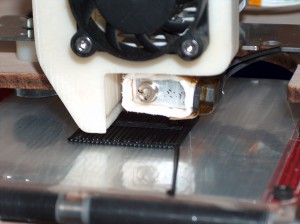All the staff and kids from our group home were walking back from the cafeteria when Jay, for no apparent reason, started screaming: a high-pitched, ear-piercing shriek like nails on a chalkboard.
Cindy, our group home leader, gently pushed Jay’s wheelchair until it was facing a wall and put on the brakes. His shrieks continued, only stopping so that he could breathe. “Why don’t you take this one?” she asked, leaning close to my ear so I could hear her.
Jay has Rett syndrome, which is very similar to autism. Or maybe autism. And perhaps something else. Nobody really seems to know for sure — but we’ve been given a plan of action for the tantrums, which essentially is to remove as many stimuli as possible and wait it out nearby. Although as a caregiver it may be instinctive to try to soothe Jay by talking or touching, this doesn’t help, and just prolongs the episode. So I have little to do but wait nearby, try not to get a headache, and make sure Jay doesn’t hurt himself — which, although very unlikely, is possible, so I’m not going to let him out of my sight.
Nobody else is in the cafeteria, so I’m soon joined by two friends who notice me sitting alone — Luke, a fellow caregiver and a patient named Kirby. Kirby has an enzymatic deficiency that somewhat mimics Tourette’s syndome’s symptoms, and his hands are restrained (wrapped in padded cuffs and chained to his chair) to keep him from hurting himself. Kirby greeted me with a hearty hello, then spit in my face.
“Oh shit,” Kirby apologized, looking mortified. “Sorry.”
“Don’t worry about it,” I smiled.”It happens.” Jay is still screaming his lungs out. Luke handed me some paper towels which he always keeps at the ready.
The three of us talk for a while over Jay’s screaming. Kirby punctuates the conversation with occasional profanity and unnecessary apologies, and every now and then the chains on his arms tighten and his body goes completely rigid. What he’s trying to do (or not do) I can only guess.
A man on crutches somewhat unsteadily comes to our table and introduces himself as David. This is unnecessary for us because all of us already know him… but he doesn’t know us, so we tell him our names, again.
David has been hit in the head by a golf ball which damaged his ability to form new memories, so that anything after the moment of impact can’t be permanently stored — like the movie Memento. The injury had two other side effects — first, it had damaged his motor skills, making it difficult for him to walk, or golf, or generally move about. Second, it has provided David with an intensely sunny disposition and charming personality that he insists he didn’t have before the accident.
David sat down next to Kirby and eyed Kirby’s restraints. “Do you shake hands, is that okay? I don’t want to be rude…”
Kirby smiled, “Well, it’s better if I don’t. I can’t always control my hands.” Kirby’s face twisted into a grimace and he shouted, “you pigfucker!”
David smiled brightly. “Well, you certainly made me feel better!”
David’s brother Tom was apparently visiting, and joined us at the table.
“Can’t you shut that kid up?” Tom said to nobody in particular, as Jay continued to shriek. I wasn’t particularly fond of Tom.
“Pigfucker!” said Kirby, but without the telltale grimace that normally accompanies an attack.
Luke stifled a laugh and announced that it was time for he and Kirby to go back, leaving me with David, who may remember me if he hasn’t looked away and thought about something else, Tom, and Jay’s wailing about 10 feet away.
“I’m David,” he introduced himself to me, holding out his hand cheerily.
Tom wore an expensive, three piece suit and nervously twirled the keys to a Porsche around his fingers. “You look tired,” David said to him — something David said to Tom a lot, which was his gentle way of saying, “you look old,” which was inevitable, because the Tom that David remembered was from twelve years earlier, before the accident.
“Will you stop saying that?” Tom pleaded. Again.
David shrugged, realizing he must have said it before.
“I’m sorry, I guess I don’t know how you guys put up with that,” Tom gestured vaguely in the direction of Jay, who took a deep breath, paused just long enough to give us hope that he might stop, then resumed his siren-like scream.
David seemed genuinely confused. “Put up with what? That kid is clearly upset, and there’s not a thing we can do about it because of his condition. But it does remind us how fortunate we are.”
“Fortunate?” Tom seemed incredulous. “You can’t remember anything, you can’t walk, you gave up your career and everything you ever loved, you’re sitting in a crappy cafeteria without any food listening to a kid scream at the top of his lungs, and you’ll never get any better. You’ll never leave this place. You’ll never remember anything. You’ll never work again. When your kids visit, you don’t recognize them, you don’t know who your grandkids are and soon you’ll stop telling me I’m tired and you’ll say ‘good lord you’re old’ every time I come and visit you. How can you consider yourself fortunate by any stretch of the imagination?”
David took Tom’s hand. “I’m happy. I can get around, I like meeting people, and now I meet people all the time. This chair is comfortable. This table’s a nice color. Everything’s new to me. I’m always learning. I can forget about absolutely anything I don’t like just by not thinking about it, and I can remember what I want by writing it down. Here’s an example.” David showed Tom something written on his hand. “It says you visit me all the time here. I wouldn’t remember that, and I’m sorry, but I love that you’re here, and it’s great that there are so many people who love and care about me. That’s what being fortunate is.”
I realized that Jay had been quiet now for a minute or two. I stepped over to see if he had returned to the world.
“How are you doing, Jay?” I asked quietly.
“Tastes more meatier!” he yelled enthusiastically, echoing the words of a commercial he’d heard. While the words may not make sense, they at least seemed to match his emotional state. We headed home.



